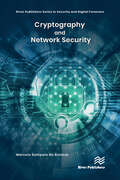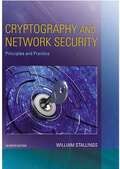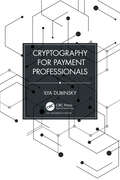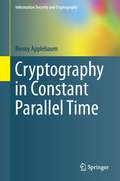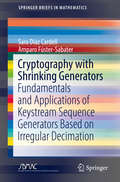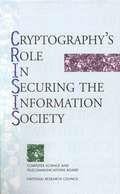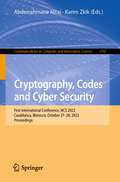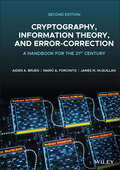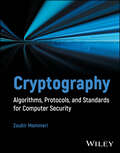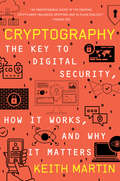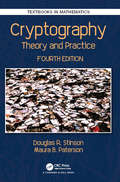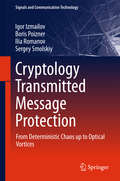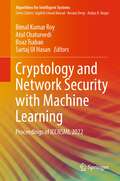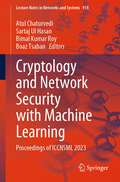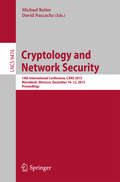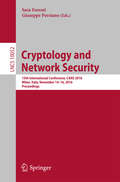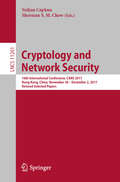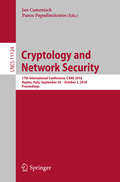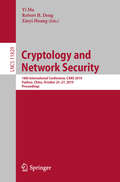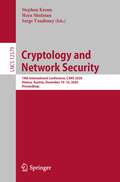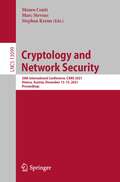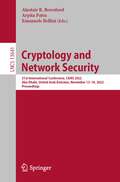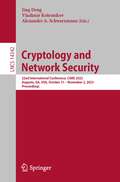- Table View
- List View
Cryptography and Network Security
by Marcelo Sampaio de AlencarStarting with the historical evolution of computer and communications networks and their security, the book then arrives at the main definitions of cryptography and network security. Next, the basics of information theory, how to measure information, the information associated with a certain source are also discussed. Source codes are presented, along with the concepts of information transmission, joint information, conditional entropy, mutual information and channel capacity. Computer networks are discussed, including the main protocols and network architectures, and the important TCP/IP protocol. Network security, a topic intrinsically connected to computer networks and the Internet, is presented, along with information about basic hacker attacks, alternatives to prevent attacks, data protection and secure protocols. The information theoretical aspects of cryptography are described including the hash function. An appendix includes a review of probability theory. Illustrations and graphics will help the reader understand the theory.
Cryptography and Network Security: Principles and Practice
by William StallingsThe Principles and Practice of Cryptography and Network Security <p><p> Stallings’ Cryptography and Network Security, Seventh Edition, introduces the reader to the compelling and evolving field of cryptography and network security. In an age of viruses and hackers, electronic eavesdropping, and electronic fraud on a global scale, security is paramount. The purpose of this book is to provide a practical survey of both the principles and practice of cryptography and network security. In the first part of the book, the basic issues to be addressed by a network security capability are explored by providing a tutorial and survey of cryptography and network security technology. The latter part of the book deals with the practice of network security: practical applications that have been implemented and are in use to provide network security. <p><p> The Seventh Edition streamlines subject matter with new and updated material ― including Sage, one of the most important features of the book. Sage is an open-source, multiplatform, freeware package that implements a very powerful, flexible, and easily learned mathematics and computer algebra system. It provides hands-on experience with cryptographic algorithms and supporting homework assignments. With Sage, the reader learns a powerful tool that can be used for virtually any mathematical application. The book also provides an unparalleled degree of support for the reader to ensure a successful learning experience.
Cryptography and Secure Communication
by Richard E. BlahutToday's pervasive computing and communications networks have created an intense need for secure and reliable cryptographic systems. Bringing together a fascinating mixture of topics in engineering, mathematics, computer science, and informatics, this book presents the timeless mathematical theory underpinning cryptosystems both old and new. Major branches of classical and modern cryptography are discussed in detail, from basic block and stream cyphers through to systems based on elliptic and hyperelliptic curves, accompanied by concise summaries of the necessary mathematical background. Practical aspects such as implementation, authentication and protocol-sharing are also covered, as are the possible pitfalls surrounding various cryptographic methods. Written specifically with engineers in mind, and providing a solid grounding in the relevant algorithms, protocols and techniques, this insightful introduction to the foundations of modern cryptography is ideal for graduate students and researchers in engineering and computer science, and practitioners involved in the design of security systems for communications networks.
Cryptography for Payment Professionals
by Ilya DubinskyAlthough cryptography plays an essential part in most modern solutions, especially in payments, cryptographic algorithms remain a black box for most users of these tools. Just as a sane backend developer does not drill down into low-level disk access details of a server filesystem, payments professionals have enough things to worry about before they ever need to bother themselves with debugging an encrypted value or a message digest. However, at a certain point, an engineer faces the need to identify a problem with a particular algorithm or, perhaps, to create a testing tool that would simulate a counterpart in a protocol that involves encryption. The world of cryptography has moved on with giant leaps. Available technical standards mention acronyms and link to more standards, some of which are very large while others are not available for free. After finding the standards for the algorithm, the specific mode of operation must also be identified. Most implementations use several cryptographic primitives—for example, key derivation with a block cipher, which produces a secret that is used together with a hash function and a double padding scheme to produce a digital signature of a base64-encoded value. Understanding this requires more sifting through online sources, more reading of platform and library documents, and finally, when some code can be written, there are very few test cases to validate it. Cryptography for Payment Professionals is intended for technical people, preferably with some background in software engineering, who may need to deal with a cryptographic algorithm in the payments realm. It does not cover the payment technology in-depth, nor does it provide more than a brief overview of some regulations and security standards. Instead, it focuses on the cryptographic aspects of each field it mentions. Highlights include: Major cryptographic algorithms and the principles of their operation Cryptographic aspects of card-present (e.g., magnetic stripe, EMV) and online (e.g., e-Commerce and 3DS 2.0) transactions A detailed description of TDES DUKPT and AES DUKPT protocols, as well as an example implementation and test cases for both It is best if the reader understands programming, number and string representations in machine memory, and bit operations. Knowledge of C, Python, or Java may make the examples easier to read but this is not mandatory. Code related to the book is available at the author’s GitHub site: https://github.com/ilya-dubinsky/cfpp
Cryptography in Constant Parallel Time (Information Security and Cryptography)
by Benny ApplebaumLocally computable (NC0) functions are "simple" functions for which every bit of the output can be computed by reading a small number of bits of their input. The study of locally computable cryptography attempts to construct cryptographic functions that achieve this strong notion of simplicity and simultaneously provide a high level of security. Such constructions are highly parallelizable and they can be realized by Boolean circuits of constant depth. This book establishes, for the first time, the possibility of local implementations for many basic cryptographic primitives such as one-way functions, pseudorandom generators, encryption schemes and digital signatures. It also extends these results to other stronger notions of locality, and addresses a wide variety of fundamental questions about local cryptography. The author's related thesis was honorably mentioned (runner-up) for the ACM Dissertation Award in 2007, and this book includes some expanded sections and proofs, and notes on recent developments. The book assumes only a minimal background in computational complexity and cryptography and is therefore suitable for graduate students or researchers in related areas who are interested in parallel cryptography. It also introduces general techniques and tools which are likely to interest experts in the area.
Cryptography with Shrinking Generators: Fundamentals and Applications of Keystream Sequence Generators Based on Irregular Decimation (SpringerBriefs in Mathematics)
by Amparo Fúster-Sabater Sara Díaz CardellThis book offers a broad survey of all information made public - from 1993 until today - on keystream sequence generators based on irregular decimation, which are referred to as shrinking generators. Starting with an overview of cryptography, it describes each type of generator - shrinking, self-shrinking, modified self-shrinking, generalized self-shrinking and the DECIM algorithm - with examples and references. Further, the book discusses several attacks on these generators and applications. It concludes by demonstrating how the output sequences can be modeled by means of different families of one-dimensional cellular automata, rendering the generators vulnerable to attacks. Intended for researchers and graduate students, the book will hopefully inspire them to search for more details on this family of generators and to address the open problems in this field.
Cryptography's Role In Securing The Information Society
by Committee to Study National Cryptography PolicyFor every opportunity presented by the information age, there is an opening to invade the privacy and threaten the security of the nation, U.S. businesses, and citizens in their private lives. The more information that is transmitted in computer-readable form, the more vulnerable we become to automated spying. It's been estimated that some 10 billion words of computer-readable data can be searched for as little as $1. Rival companies can glean proprietary secrets . . . anti-U.S. terrorists can research targets . . . network hackers can do anything from charging purchases on someone else's credit card to accessing military installations. With patience and persistence, numerous pieces of data can be assembled into a revealing mosaic. Cryptography's Role in Securing the Information Society addresses the urgent need for a strong national policy on cryptography that promotes and encourages the widespread use of this powerful tool for protecting of the information interests of individuals, businesses, and the nation as a whole, while respecting legitimate national needs of law enforcement and intelligence for national security and foreign policy purposes. This book presents a comprehensive examination of cryptography--the representation of messages in code--and its transformation from a national security tool to a key component of the global information superhighway. The committee enlarges the scope of policy options and offers specific conclusions and recommendations for decision makers. Cryptography's Role in Securing the Information Society explores how all of us are affected by information security issues: private companies and businesses; law enforcement and other agencies; people in their private lives. This volume takes a realistic look at what cryptography can and cannot do and how its development has been shaped by the forces of supply and demand. How can a business ensure that employees use encryption to protect proprietary data but not to conceal illegal actions? Is encryption of voice traffic a serious threat to legitimate law enforcement wiretaps? What is the systemic threat to the nation's information infrastructure? These and other thought-provoking questions are explored. Cryptography's Role in Securing the Information Society provides a detailed review of the Escrowed Encryption Standard (known informally as the Clipper chip proposal), a federal cryptography standard for telephony promulgated in 1994 that raised nationwide controversy over its "Big Brother" implications. The committee examines the strategy of export control over cryptography: although this tool has been used for years in support of national security, it is increasingly criticized by the vendors who are subject to federal export regulation. The book also examines other less well known but nevertheless critical issues in national cryptography policy such as digital telephony and the interplay between international and national issues. The themes of Cryptography's Role in Securing the Information Society are illustrated throughout with many examples -- some alarming and all instructive -- from the worlds of government and business as well as the international network of hackers. This book will be of critical importance to everyone concerned about electronic security: policymakers, regulators, attorneys, security officials, law enforcement agents, business leaders, information managers, program developers, privacy advocates, and Internet users.
Cryptography, Codes and Cyber Security: First International Conference, I4CS 2022, Casablanca, Morocco, October 27-28, 2022, Proceedings (Communications in Computer and Information Science #1747)
by Abderrahmane Nitaj Karim ZkikThis book constitutes the refereed First International Conference on Cryptography, Codes and Cyber Security, I4CS 2022, held in Casablanca, Morocco, during October 27-28, 2022.The 4 full papers and 3 invited papers presented in this book were carefully reviewed and selected from 12 submissions. They were organized in topical sections as invited papers and contributed papers.
Cryptography, Information Theory, and Error-Correction: A Handbook for the 21st Century (Wiley Series In Discrete Mathematics And Optimization Ser. #68)
by Aiden A. Bruen Mario A. Forcinito James M. McQuillanCRYPTOGRAPHY, INFORMATION THEORY, AND ERROR-CORRECTION A rich examination of the technologies supporting secure digital information transfers from respected leaders in the fieldAs technology continues to evolve Cryptography, Information Theory, and Error-Correction: A Handbook for the 21ST Century is an indispensable resource for anyone interested in the secure exchange of financial information. Identity theft, cybercrime, and other security issues have taken center stage as information becomes easier to access. Three disciplines offer solutions to these digital challenges: cryptography, information theory, and error-correction, all of which are addressed in this book.This book is geared toward a broad audience. It is an excellent reference for both graduate and undergraduate students of mathematics, computer science, cybersecurity, and engineering. It is also an authoritative overview for professionals working at financial institutions, law firms, and governments who need up-to-date information to make critical decisions. The book’s discussions will be of interest to those involved in blockchains as well as those working in companies developing and applying security for new products, like self-driving cars. With its reader-friendly style and interdisciplinary emphasis this book serves as both an ideal teaching text and a tool for self-learning for IT professionals, statisticians, mathematicians, computer scientists, electrical engineers, and entrepreneurs.Six new chapters cover current topics like Internet of Things security, new identities in information theory, blockchains, cryptocurrency, compression, cloud computing and storage. Increased security and applicable research in elliptic curve cryptography are also featured. The book also:Shares vital, new research in the field of information theoryProvides quantum cryptography updatesIncludes over 350 worked examples and problems for greater understanding of ideas.Cryptography, Information Theory, and Error-Correction guides readers in their understanding of reliable tools that can be used to store or transmit digital information safely.
Cryptography: A Very Short Introduction
by Fred Piper Sean MurphyProvide information about cryptography, gives tips and techniques.
Cryptography: Algorithms, Protocols, and Standards for Computer Security
by Zoubir Z. MammeriCryptography An introduction to one of the backbones of the digital world Cryptography is one of the most important aspects of information technology security, central to the protection of digital assets and the mitigation of risks that come with increased global connectivity. The digital world is wholly reliant on secure algorithms and protocols for establishing identity, protecting user data, and more. Groundbreaking recent developments in network communication and a changing digital landscape have been accompanied by similar advances in cryptography, which is more central to digital life than ever before. This book constitutes a comprehensive yet accessible introduction to the algorithms, protocols, and standards which protect the modern internet. Built around both foundational theories and hundreds of specific algorithms, it also incorporates the required skills in complex mathematics. The result is an indispensable introduction to the protocols and systems which should define cryptography for decades to come. Readers will also find: Over 450 problems with accompanying solutions to reinforce key concepts and test retention Detailed discussion of topics including symmetric and asymmetric algorithms, random number generation, user authentication, and many more Over 200 figures and tables that provide rich detail to the content Cryptography: Algorithms, Protocols, and Standards for Computer Security is ideal for undergraduate and graduate students in cryptography and information technology subjects, as well as for researchers looking for a working reference on existing cryptographic algorithms and protocols.
Cryptography: The Key To Digital Security, How It Works, And Why It Matters
by Keith MartinA nuts-and-bolts explanation of cryptography from a leading expert in information security. Despite its reputation as a language only of spies and hackers, cryptography plays a critical role in our everyday lives. Though often invisible, it underpins the security of our mobile phone calls, credit card payments, web searches, internet messaging, and cryptocurrencies—in short, everything we do online. Increasingly, it also runs in the background of our smart refrigerators, thermostats, electronic car keys, and even the cars themselves. As our daily devices get smarter, cyberspace—home to all the networks that connect them—grows. Broadly defined as a set of tools for establishing security in this expanding cyberspace, cryptography enables us to protect and share our information. Understanding the basics of cryptography is the key to recognizing the significance of the security technologies we encounter every day, which will then help us respond to them. What are the implications of connecting to an unprotected Wi-Fi network? Is it really so important to have different passwords for different accounts? Is it safe to submit sensitive personal information to a given app, or to convert money to bitcoin? In clear, concise writing, information security expert Keith Martin answers all these questions and more, revealing the many crucial ways we all depend on cryptographic technology. He demystifies its controversial applications and the nuances behind alarming headlines about data breaches at banks, credit bureaus, and online retailers. We learn, for example, how cryptography can hamper criminal investigations and obstruct national security efforts, and how increasingly frequent ransomware attacks put personal information at risk. Yet we also learn why responding to these threats by restricting the use of cryptography can itself be problematic. Essential reading for anyone with a password, Cryptography offers a profound perspective on personal security, online and off.
Cryptography: Theory and Practice (Fourth Edition) (Textbooks in Mathematics #2012)
by Douglas Robert Stinson Maura Paterson<p>Through three editions, Cryptography: Theory and Practice, has been embraced by instructors and students alike. It offers a comprehensive primer for the subject’s fundamentals while presenting the most current advances in cryptography. <p>The authors offer comprehensive, in-depth treatment of the methods and protocols that are vital to safeguarding the seemingly infinite and increasing amount of information circulating around the world.</p>
Cryptology Transmitted Message Protection: From Deterministic Chaos up to Optical Vortices (Signals and Communication Technology)
by Igor Izmailov Boris Poizner Ilia Romanov Sergey SmolskiyThis book presents methods to improve information security for protected communication. It combines and applies interdisciplinary scientific engineering concepts, including cryptography, chaos theory, nonlinear and singular optics, radio-electronics and self-changing artificial systems. It also introduces additional ways to improve information security using optical vortices as information carriers and self-controlled nonlinearity, with nonlinearity playing a key "evolving" role. The proposed solutions allow the universal phenomenon of deterministic chaos to be discussed in the context of information security problems on the basis of examples of both electronic and optical systems. Further, the book presents the vortex detector and communication systems and describes mathematical models of the chaos oscillator as a coder in the synchronous chaotic communication and appropriate decoders, demonstrating their efficiency both analytically and experimentally. Lastly it discusses the cryptologic features of analyzed systems and suggests a series of new structures for confident communication.
Cryptology and Network Security with Machine Learning: Proceedings of ICCNSML 2022 (Algorithms for Intelligent Systems)
by Bimal Kumar Roy Atul Chaturvedi Boaz Tsaban Sartaj Ul HasanThe book features original papers from International Conference on Cryptology & Network Security with Machine Learning (ICCNSML 2022), organized by PSIT, Kanpur, India during 16 – 18 December 2022. This conference proceeding will provide the understanding of core concepts of Cryptology & Network Security with ML in data communication. The book covers research papers in public key cryptography, elliptic curve cryptography, post quantum cryptography, lattice based cryptography, non-commutative ring based cryptography, cryptocurrency, authentication, key agreement, Hash functions, block/stream ciphers, polynomial based cryptography, code based cryptography, NTRU cryptosystems, security and privacy in machine learning, block chain, IoT security, wireless security protocols, cryptanalysis, number theory, quantum computing, cryptographic aspects of network security, complexity theory, and cryptography with machine learning.
Cryptology and Network Security with Machine Learning: Proceedings of ICCNSML 2023 (Lecture Notes in Networks and Systems #918)
by Bimal Kumar Roy Atul Chaturvedi Boaz Tsaban Sartaj Ul HasanThe book features original papers from International Conference on Cryptology & Network Security with Machine Learning (ICCNSML 2023), organized by PSIT, Kanpur, India during 27–29 October 2023. This conference proceeding provides the understanding of core concepts of Cryptology and Network Security with ML in data communication. The book covers research papers in public key cryptography, elliptic curve cryptography, post-quantum cryptography, lattice based cryptography, non-commutative ring-based cryptography, cryptocurrency, authentication, key agreement, Hash functions, block/stream ciphers, polynomial-based cryptography, code-based cryptography, NTRU cryptosystems, security and privacy in machine learning, blockchain, IoT security, wireless security protocols, cryptanalysis, number theory, quantum computing, cryptographic aspects of network security, complexity theory, and cryptography with machine learning.
Cryptology and Network Security: 14th International Conference, CANS 2015, Marrakesh, Morocco, December 10-12, 2015, Proceedings (Lecture Notes in Computer Science #9476)
by Michael Reiter David NaccacheThis book constitutes the refereed proceedingsof the 14th International Conference on Cryptology and Network Security, CANS2015, held in Marrakesh, Morocco, in December 2015. The 12 full papers presented together with 6short papers were carefully reviewed and selected from numerous submissions. Thepapers cover topics of interest such as internet of things and privacy;password-based authentication; attacks and malicious code; security modelingand verification; secure multi-party computation; and cryptography and VPNs.
Cryptology and Network Security: 15th International Conference, CANS 2016, Milan, Italy, November 14-16, 2016, Proceedings (Lecture Notes in Computer Science #10052)
by Sara Foresti and Giuseppe PersianoThis book constitutes the refereed proceedings of the 15th International Conference on Cryptology and Network Security, CANS 2016, held in Milan, Italy, in November 2016.The 30 full papers presented together with 18 short papers and 8 poster papers were carefully reviewed and selected from 116 submissions. The papers are organized in the following topical sections: cryptanalysis of symmetric key; side channel attacks and implementation; lattice-based cryptography, virtual private network; signatures and hash; multi party computation; symmetric cryptography and authentication; system security, functional and homomorphic encryption; information theoretic security; malware and attacks; multi party computation and functional encryption; and network security, privacy, and authentication.
Cryptology and Network Security: 16th International Conference, CANS 2017, Hong Kong, China, November 30—December 2, 2017, Revised Selected Papers (Lecture Notes in Computer Science #11261)
by Srdjan Capkun Sherman S. ChowThis book contains revised versions of all the papers presented at the 16th International Conference on Cryptology and Network Security, CANS 2017, held in Hong Kong, China, in November/ December 2017. The 20 full papers presented together with 8 short papers were carefully reviewed and selected from 88 submissions. The full papers are organized in the following topical sections: foundation of applied cryptography; processing encrypted data; predicate encryption; credentials and authentication; web security; Bitcoin and blockchain; embedded system security; anonymous and virtual private networks; and wireless and physical layer security.
Cryptology and Network Security: 17th International Conference, CANS 2018, Naples, Italy, September 30 – October 3, 2018, Proceedings (Lecture Notes in Computer Science #11124)
by Jan Camenisch Panos PapadimitratosThis book constitutes the refereed proceedings of the 17th International Conference on Cryptology and Network Security, CANS 2018, held in Naples, Italy, in September/October 2018. The 26 full papers were carefully reviewed and selected from 79 submissions. The papers are organized in the following topical sections: privacy; Internet misbehavior and protection; malware; symmetric key cryptography; signatures; cryptanalysis; cryptographic primitives; and cryptographic protocols.
Cryptology and Network Security: 18th International Conference, CANS 2019, Fuzhou, China, October 25–27, 2019, Proceedings (Lecture Notes in Computer Science #11829)
by Robert H. Deng Xinyi Huang Yi MuThis book constitutes the refereed proceedings of the 18th International Conference on Cryptology and Network Security, CANS 2019, held in Fuzhou, China, in October 2019.The 21 full papers and 8 short papers were carefully reviewed and selected from 55 submissions. The papers focus on topics such as homomorphic encryption; SIKE and Hash; lattice and post-quantum cryptography; searchable encryption; blockchains, cloud security; secret sharing and interval test, LWE; encryption, data aggregation, and revocation; and signature, ML, payment, and factorization.
Cryptology and Network Security: 19th International Conference, CANS 2020, Vienna, Austria, December 14–16, 2020, Proceedings (Lecture Notes in Computer Science #12579)
by Stephan Krenn Serge Vaudenay Haya ShulmanThis book constitutes the refereed proceedings of the 19th International Conference on Cryptology and Network Security, CANS 2020, held in Vienna, Austria, in December 2020.*The 30 full papers were carefully reviewed and selected from 118 submissions. The papers focus on topics such as cybersecurity; credentials; elliptic curves; payment systems; privacy-enhancing tools; lightweight cryptography; and codes and lattices. *The conference was held virtually due to the COVID-19 pandemic.
Cryptology and Network Security: 20th International Conference, CANS 2021, Vienna, Austria, December 13-15, 2021, Proceedings (Lecture Notes in Computer Science #13099)
by Mauro Conti Stephan Krenn Marc StevensThis book constitutes the refereed proceedings of the 20th International Conference on Cryptology and Network Security, CANS 2021, which was held during December 13-15, 2021. The conference was originally planned to take place in Vienna, Austria, and changed to an online event due to the COVID-19 pandemic.The 25 full and 3 short papers presented in these proceedings were carefully reviewed and selected from 85 submissions. They were organized in topical sections as follows: Encryption; signatures; cryptographic schemes and protocols; attacks and counter-measures; and attestation and verification.
Cryptology and Network Security: 21st International Conference, CANS 2022, Dubai, United Arab Emirates, November 13–16, 2022, Proceedings (Lecture Notes in Computer Science #13641)
by Arpita Patra Alastair R. Beresford Emanuele BelliniThis book constitutes the refereed proceedings of the 21st International Conference on Cryptology and Network Security, CANS 2022, which was held during November 13-16, 2022. The conference was took place in Abu Dhabi, United Arab Emirates.The 18 full and 2 short papers presented in these proceedings were carefully reviewed and selected from 54 submissions. They were organized in topical sections as follows: zero-knowledge and MPC; public-key infrastructure; attacks and countermeasures; cryptanalysis and provable security; cryptographic protocols; blockchain and payment systems; and codes and post-quantum cryptography.
Cryptology and Network Security: 22nd International Conference, CANS 2023, Augusta, GA, USA, October 31 – November 2, 2023, Proceedings (Lecture Notes in Computer Science #14342)
by Vladimir Kolesnikov Alexander A. Schwarzmann Jing DengThis book constitutes the refereed proceedings of the 22nd International Conference on Cryptology and Network Security, CANS 2023, which was held in October/November 2023 in Augusta, GA, USA.The 25 papers presented were thoroughly revised and selected from the 54 submissions. They are organized in the following topical sections: Schemes I; Basic Primitives; Security; MPC with Cards; Blockchain; MPC and Secret Sharing; Schemes II.
